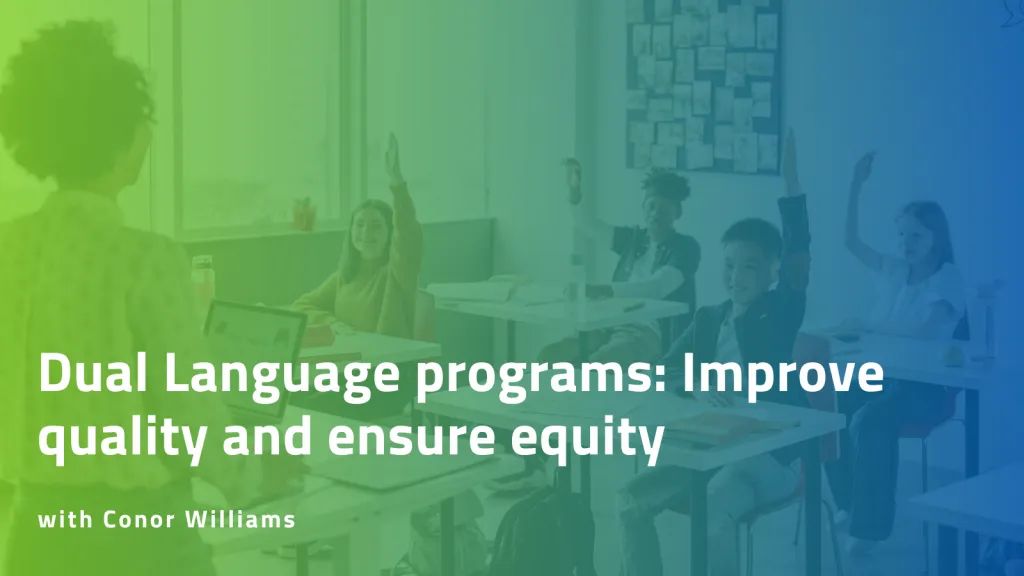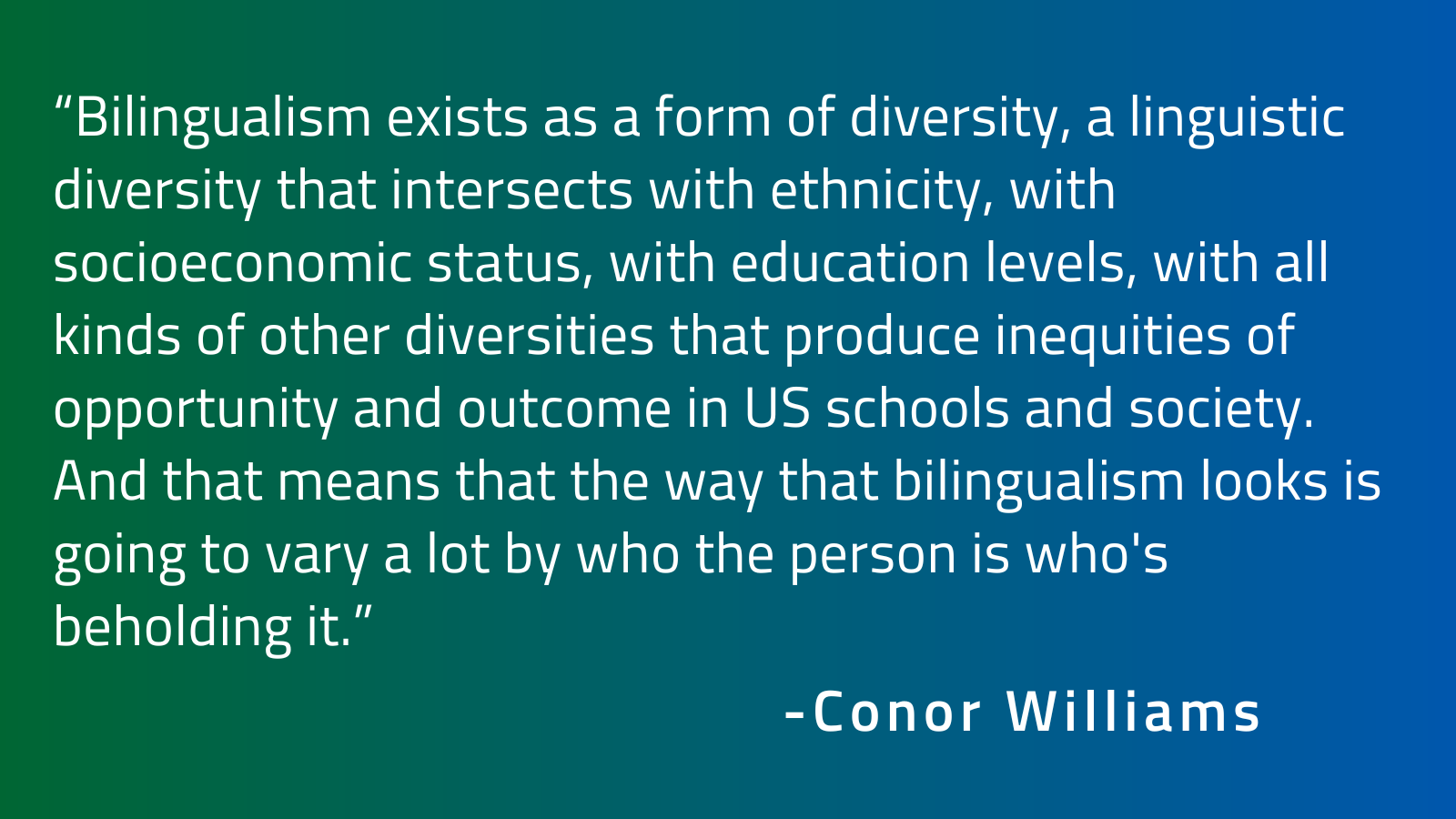Dual language programs: Systems for ensuring equitable access


Dual language programs: Systems for ensuring equitable access
Bilingualism is increasingly viewed as an asset for students and professionals across the US. Accordingly, dual language immersion programs have become a sought-after option in K-12 education. But as the benefits of the programs are being publicized not only for English learners, but also for native English speakers, questions of equity and access have increased.
Conor Williams, a senior fellow at The Century Foundation, shares his insight on improving equitable access to high-quality dual language immersion (DL) programs while protecting the unique benefits they offer.
Listen to the full episode here, and find key takeaways from the conversation below.
Why has interest increased in dual language immersion programs?
In a dual language (DL) program, the class is an equal balance between students who are native English speakers and whose first language is a language other than English; the material is taught in both languages. They are widely shown to be one of the most effective ways for students to become multilingual, and while for many years experts have advocated for these programs to be offered for English learners, there are a number of reasons contributing to the growing demand.
1. Multilingual stylistic + functional appeal:
Dual language immersion programs have gained popularity as multilingualism becomes an increasingly attractive professional quality. Many parents of English-speaking students seek the unique educational experience as well as the prestigious pursuit of bilingualism for their children. In addition, being bilingual in English and Spanish is highly functional culturally, economically, and socially in the US.
2. Community connection:
Beyond the trend, many communities appreciate DL programs for the ties to their unique cultures, allowing students to bring their linguistic assets to the school environment and empowering all students in the program to become more well-rounded and exposed to more linguistic and cultural diversity.
3. English language developmental success:
Studies reveal that dual language immersion programs are particularly effective for English (EL) learners to succeed academically, to maintain their emerging bilingual skills and their native language, and to master the English language.
The list goes on, but what is clear is that the value - and appeal - of a dual language program can vary significantly by the individual participating.

What all successful dual language programs need
With this growing popularity of dual language programs, there also comes a need for guidance around implementation or best practices to ensure that all programs are high quality and offer equitable access.
Williams notes that although recommendations are more theoretical than proven at this stage, most experts agree that the most successful dual language programs enroll native speakers of both languages.
For the program to be effective, there is first and foremost a need for an equal balance between multilingual enrichment for English-dominant students and opportunities for English Language Learners (ELs) - setting up the right conditions for social language and “peer effects.”
“Take a one-way dual immersion class where everybody in the class is an English dominant student and you have one native Welsh speaker as the teacher. Half the day is in Welsh, half the day is in English. But if there are no native Welsh speakers amongst the students, they’re going to keep defaulting back to English every time a problem or challenge arises. But if you have native speakers of Welsh and English in the classroom and the academic instruction is coming in both languages, and the language of the playground is both - now the language development can happen.”
Strategies to foster & maintain equity
Considering the potential for gentrification of dual language programs amongst wealthy, privileged, often white communities, it is important to build equitable policies into a DL program’s design to protect access for non-native English speakers.
Some techniques that have worked in other districts include:
- Language-Based Seat Reservations: While civil rights obligations prevent seat reservations based on race, they allow reservations based on language. Lottery enrollment by students' dominant language is suggested to maintain fairness.
- Transportation and Boundaries: Establishing transportation and school boundaries that facilitate entry for diverse students is crucial for ensuring access.
- Backfill Policies: DL programs with backfill policies, or admitting students after the first grade/initial year, should specify that a percentage of new students added must prove reasonable proficiency in a language other than English.
Additionally, communities should work to build a bigger pipeline and increase the number of bilingual teachers. There's a significant demand for bilingual teachers, emphasizing the importance of investing in teacher preparation programs. Two strong places to start are:
- Building connections between DL programs and teacher preparation programs can contribute to the gradual increase of graduating bilingual/biliterate students.
- Additionally, it is crucial to overcome financial barriers with compensation such as unpaid student teaching roles and differentiating salaries for hard-to-fill roles to facilitate, rather than discourage, filling these specialized positions.
For more challenges facing implementation and sustainability of dual language programs and strategies to overcome them, listen to our full interview with Conor Williams.
Download the full episode transcript here, and find the report from The Century Foundation referenced throughout.
Conor Williams is a regular columnist at the 74 Million. His work has also been published by the New York Times, Atlantic Monthly, Washington Post, and elsewhere. Williams was previously a senior researcher in New America’s Education Policy Program, a senior researcher in its Early Education Initiative, and the founding director of its Dual Language Learners National Work Group. He has taught postsecondary courses at Georgetown University, George Washington University, and American University. He is a member of the Children’s Equity Project and the National Conference of State Legislatures’ State Policy and Research for Early Education (SPREE) Working Group.